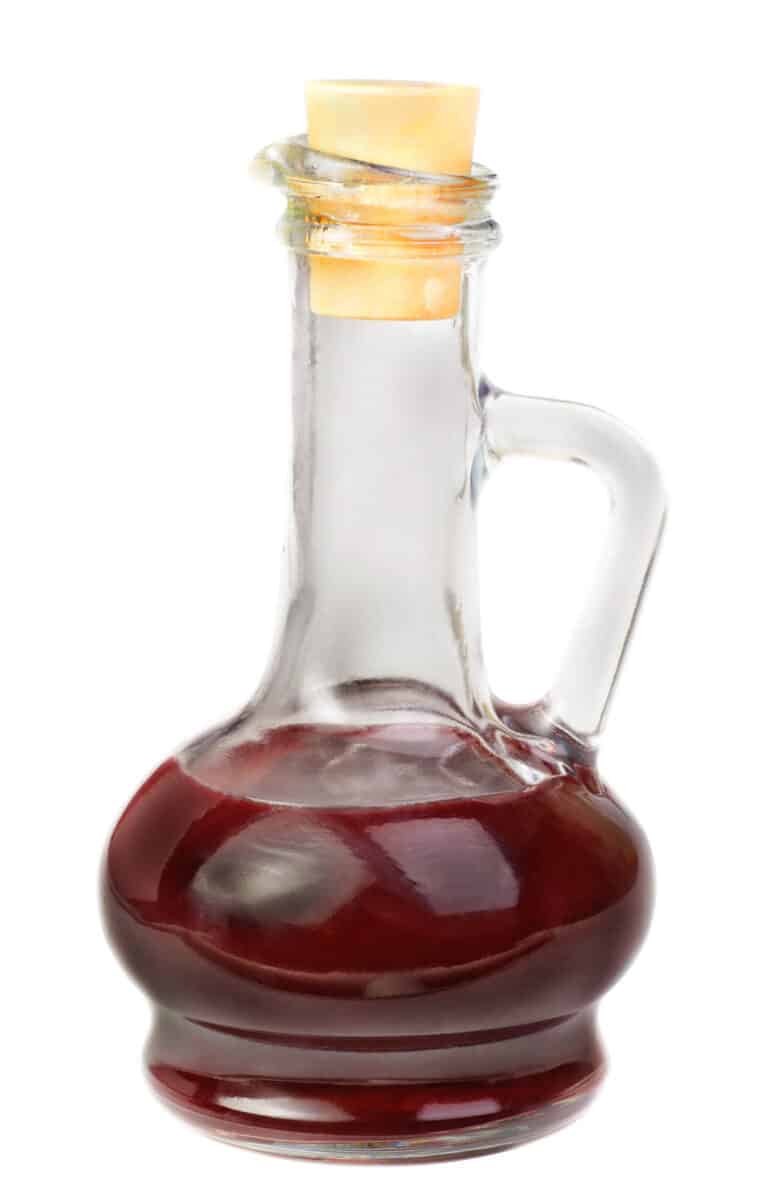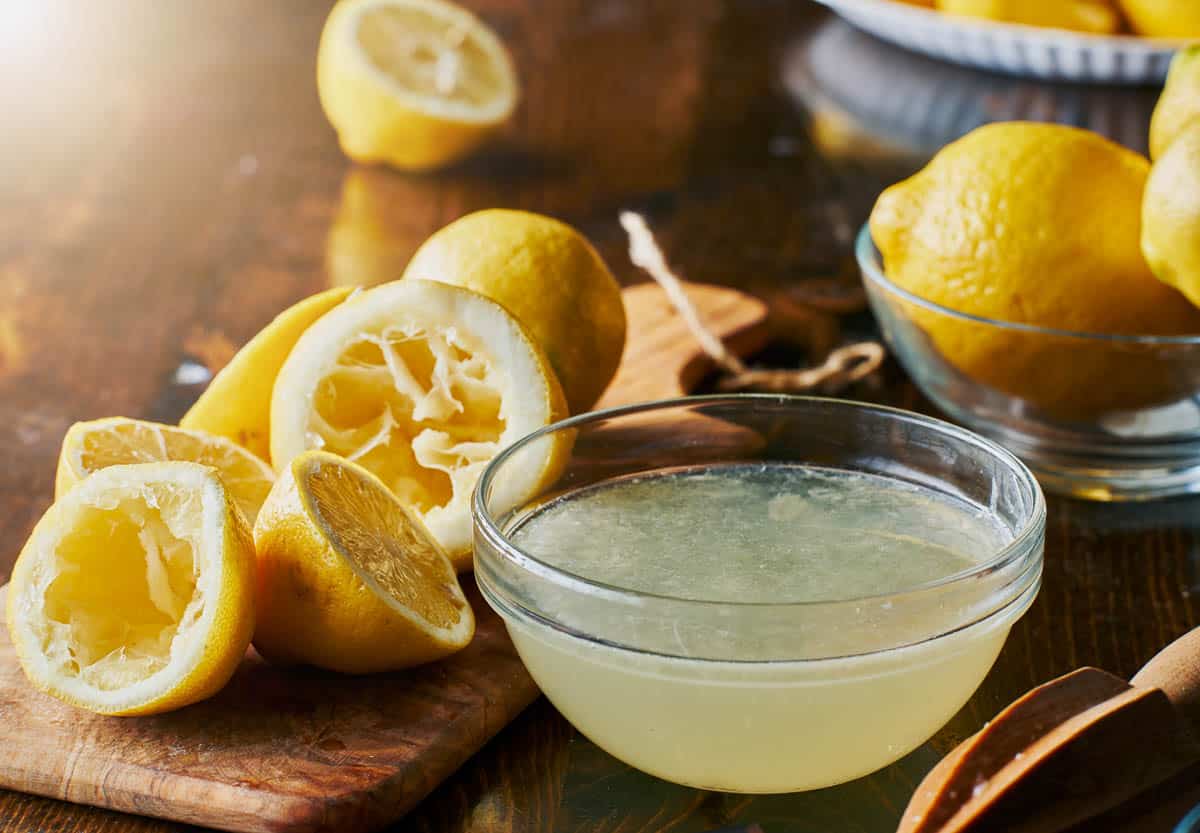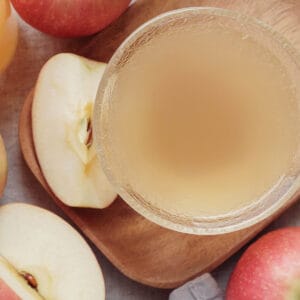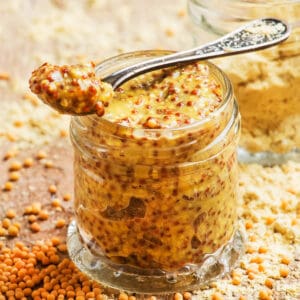Red wine vinegar brings a unique and complex flavor to a variety of recipes. Moreover, both vinegar and moderate red wine consumption are associated with many health benefits.
Despite its complex flavor, red wine vinegar can be substituted if desired. To understand which substitute is best, it helps to first understand how red wine vinegar is made and what it brings to recipes.

What is Red Wine Vinegar?
As the name implies, this type of vinegar is made from red wine. The alcohol in red wine is fermented until it turns into acetic acid, giving the wine a nice tangy and robust flavor.
The fermentation process begins when red wine is exposed to the oxygen in the air. Then, the bacteria (acetic acid bacteria) in the air convert the ethanol or alcohol sugars to acetic acid.
How is it Made?
Commercially produced red wine vinegar uses one of 3 different processes. These include the Orleans, Generator, and the Submerged methods.
The Orleans method is a French process dating back to the Middle Ages. The alcohol liquid is poured into wooden barrels with the necessary bacteria and kept in a dark, temperature controlled environment where it is aged 12-24 months.
The Generator method utilizes large wood vats filled with wood shavings, grape pulp, or charcoal moistened with vinegar. The alcohol liquid drips from the top of the vat slowly through the medium. Air is forced through holes and into the vat, providing a controlled aeration. When the liquid reaches the bottom, it has been converted to vinegar. This takes anywhere from several days to several weeks.
The Submerged method uses steel vats equipped with aerators on the bottom to pump air bubbles up and into the mixture. As the pump stirs the alcohol, nutrients are pumped into the tank to encourage the growth of acetic acid bacteria. This is the fastest and most efficient method of production, taking just hours to complete.

Are All Red Wine Vinegars the Same?
Not all red wines are the same, and neither are the vinegars they produce. Soil, grapes, unique regional practices, and aging processes are just a few examples of different factors that will affect the taste.
Some varieties are even made with specific types of red wine. Merlot and pinot noir, for example, are two unique and expensive varieties that you will often see at high end grocers and specialty stores.
How is it Used?
Red wine vinegar has been a staple ingredient in the Mediterranean diet. It is used in sauces, salad dressings, and marinades for meats and vegetables.
This type of vinegar has a tangy and subtly sweet flavor that complements hearty dishes the best. It is also often used with red meat, as the natural acidity tenderizes it.

Best Substitutes for Red Wine Vinegar
If a recipe calls for red wine vinegar, the acidic properties make it hard to omit. Whenever possible, always make a substitution. The following list if ingredients are suitable alternatives that are both common and easy to substitute. You may even have a few of these options in your pantry already!
White Wine Vinegar
This is considered the best red wine vinegar substitute because it is so similar in acidity. White wine vinegar has a mild flavor compared to red wine vinegar, yet some people perceive it to be slightly more sweet.
To bring a stronger flavor into the recipe, you can either add more white wine vinegar or throw in a splash of your favorite red wine (more details in the following section).
- Flavor Profile: Tangy, sour, and slightly more sweet.
- Substitution: Use a 1:1 ratio. For example, use 1 tablespoon of white wine vinegar for every 1 tablespoon red wine vinegar.
- Special Notes: To enhance flavor, use slightly more than 1:1 ratio, or add extra red wine. Keep in mind the white wine vinegar is lighter, so it pairs well with recipes for fish, poultry, and other dishes commonly associated with white wine.
White Vinegar and Red Wine
This combination is perhaps the second best alternative to red wine vinegar. As mentioned above, white wine vinegar provides a similar acidity and flavor profile. However, some prefer to add a bit of their favorite red wine for an added fruity flavor.
You can use this mix in any recipe that calls for red wine vinegar. It goes especially well in dressings and marinades.
- Flavor Profile: Similar to white wine vinegar, but with added tang and fruitiness.
- Substitution: Use a 1:1 ratio of white vinegar and red wine, then substitute 1:1. For example, 2 tablespoon red wine vinegar can be substituted with a mix of 1 tablespoon white vinegar and 1 tablespoon red wine.
- Special Notes: Another ratio worth mentioning is 1 part red wine to 3 parts white vinegar. This is a bit less fruity and pairs well with chicken, poultry, and other recipes associated with white wine.

Balsamic Vinegar
Balsamic vinegar is made from grape must, either fully or partially. Grape must is crushed grape juice including stems, seeds, and skins. When white wine vinegar is not available, balsamic is often the next best alternative to try.
The two best types include Traditional Balsamic of Modena and Traditional Balsamic of Reggio Emilia. These have been aged at least 12 years and have a balance of sweet and sour flavors.
A third and sometimes easier variety to find is commercial-grade Balsamic Vinegar of Modena. This special variety requires at least 2 to 3 years to age. And it is made using only 20% grape must along with wine vinegar, artificial colorings and thickeners to mimic the traditional balsamic.
- Flavor Profile: Balanced sweet and sour flavors.
- Substitution: Use a 1:1 ratio. For example, use 1 tablespoon of balsamic for every 1 tablespoon red wine vinegar.
- Special Notes: Keep in mind that balsamic is naturally sweeter. If the recipe calls for other sweeteners, like sugar or honey, consider reducing the amount at first. If possible, sweeten to taste later.

Sherry Vinegar
Sherry vinegar lies somewhere between red wine vinegar and balsamic. It is produced in Spain, in the Jerez denomination, in the area known as the Sherry Triangle. Interestingly, Sherry has a protected designation, so there is more control and flavor consistency across different varieties.
Sherry vinegar is aged in oak barrels for a minimum of 6 months. The Reserva variety is aged 2 years, and the Gran Reserva is aged 10. As with balsamic vinegar, the longer it is aged the more expensive it is.
Sherry vinegar has a richly complex flavor with a nuttiness and can easily be used in place of red wine vinegar. This option is great for vinaigrettes, marinades, drizzled on vegetables, in soups, and on a caprese salad. Popular in Spanish cuisine, it is also used in gazpacho.
- Flavor Profile: Bright and complex. Rich, nutty, and slightly sweet.
- Substitution: Use a 1:1 ratio. For example, use 1 tablespoon of sherry vinegar for every 1 tablespoon red wine vinegar.
- Special Notes: Ideal for Spanish cuisine, like gazpacho. Also great in vinaigrettes, marinades, soups, and used as a drizzle for vegetables or caprese salad.
Champagne Vinegar
Champagne vinegar is fermented, just like the other alternatives mentioned above. What makes it unique, however, are the grapes used and the aging process.
This type of vinegar is made from pinot noir and chardonnay grapes. Authentic champagne vinegar is then aged up to 2 years in oak barrels.
The taste is mild, light and floral. It does not have the acidity associated with red wine vinegar, but still has fruity notes. This makes it a great substitute in vinaigrettes, marinades and sauces.
- Flavor Profile: Mild, light, and floral.
- Substitution: Start with a 1:1 ratio, then add more champagne vinegar as desired.

Rice Vinegar (also known as Rice Wine Vinegar)
As the name implies, this vinegar is made from rice and is popular in Asian cuisines.
First, rice is cooked and fermented with a yeast product to make wine. Then, the rice wine has to undergo an oxidation process, during which the wine’s alcohol content is converted to acetic acid.
The old tradition of making rice wine vinegar takes time for the conversion of alcohol to acetic acid. This slow process results in a more distinct taste. To meet the demand and to improve production efficiency, generator and submerged production methods are used (as discussed above).
The taste of rice wine vinegar is milder and less acidic. When substituting, make sure you are using unseasoned rice wine vinegar as the seasoned variety may add unwanted sugar, salt, and flavor notes.
Rice vinegar is used in many Asian dishes, soups, stir fries, marinades, pickling recipes, sweet and sour dishes, and on fries.
- Flavor Profile: Sweet and acidic. More similar to apple cider vinegar than to red or white wine varieties.
- Substitution: Use a 1:1 ratio. For example, use 1 tablespoon of rice vinegar for every 1 tablespoon red wine vinegar.
- Special Notes: Always start with a 1:1 ratio, however, you may have to add more rice wine vinegar to get closer to the acidic taste of red wine vinegar.
Lemon Juice or Lime Juice
Both lemon and lime juice have citric acid as opposed to the acetic acid in red wine vinegar. As citric juices, both can bring a nice acidity to your recipe.
However, the flavor profile is notably different from red wine. They, therefore, are not as versatile and can’t be substituted for red wine vinegar in all recipes. These are not the best substitutes but will do in a pinch.
Fresh lemon and limes are best used in recipes that call for small quantities. Let the lemon or lime come to room temperature then roll them on the counter. This makes it easier to extract the juice.
- Flavor Profile: Tart, acidic, with a hint of sweetness. Lime is bright and zesty, whereas lemon is aromatic and slightly bitter.
- Substitution: Use a 2:1 ratio. For example, use 2 tablespoon lemon or lime juice for every 1 tablespoon red wine vinegar.
- Special Notes: Best for use in vinaigrettes and marinades. Not ideal substitutes, but will work well in a pinch.

Tamarind Paste
Tamarind is a tropical fruit that comes from the leguminous tamarind tree. The reason it is classified as leguminous is because the fruit is grown in a bean-like pod. As the pulp ripens, it becomes thick like molasses with a sweet and sour taste.
Tamarind is high in fruit sugar but low on the glycemic index. For this reason, it does not spike blood sugar and insulin levels like processed, high sugar foods.
While tamarind originated in Africa, it is grown in tropical regions such as Mexico and South Asia. Mexico and Thailand are the major producers.
Tamarind contains tartaric acid, which is a naturally occurring acid found in many plants, including wine grapes. It is one of the chief acids in wine and has a more pungent sour taste.
Tamarind paste works well as a substitute in marinades for fish and meat, as well as for tenderizing meat. A word of caution, however: Tamarind has a strong taste that may not work well outside of fish and meat applications.
- Flavor Profile: Sweet and sour, yet tangy and tart.
- Substitution: Use a ½ : 1 ratio. For example, use ½ tablespoon tamarind paste for every 1 tablespoon red wine vinegar.
- Special Notes: Tamarind is the “secret” ingredient in Worcestershire sauce, and it is best for fish and meat recipes. A strong and unique flavor, this alternative may not be suitable for much else.
Raspberry Vinegar
Raspberry vinegar is made not from fermented raspberries, but rather from white wine or champagne vinegar. Raspberries are added to this base after being pureed and strained to remove seeds.
This alternative is best used for vinaigrettes for salads. Due to its slightly sweeter and fruitier taste, raspberry vinegar may not be suitable for all recipes.
- Flavor Profile: Tangy, sweet, and slightly tart.
- Substitution: Use a 1:1 ratio. For example, use 1 tablespoon raspberry vinegar for every 1 tablespoon red wine vinegar.

Apple Cider Vinegar
This is a great substitute for red wine vinegar. Apple cider vinegar is made from fermented apples. The 2-step fermentation process involves first turning the carbohydrates into alcohol, then converting the alcohol into acetic acid. The result is apple cider vinegar.
The taste of apple cider vinegar is fruity with less acidity than red wine vinegar and a sweeter flavor. It is not well suited for savory dishes, so it is best used in dressings, vinaigrettes, and pickling recipes.
- Flavor Profile: Fruity, less acidic, and slightly sweet.
- Substitution: Use a 1:1 ratio. For example, use 1 tablespoon apple cider vinegar for every 1 tablespoon red wine vinegar.
- Special Notes: Not a good substitute for savory dishes. Instead, try this substitute in dressings, vinaigrettes, and pickling recipes.

There are plenty of alternatives to red wine vinegar, from other varieties of vinegar to citrus fruits and even tamarind paste. Each has unique flavors, so be sure to follow the substitution and special notes listed above. Happy cooking!
Do you have any other tried and true substitution recommendations? Please let me know in the comments!






Leave a Reply